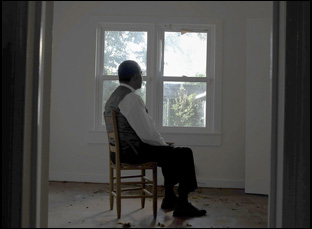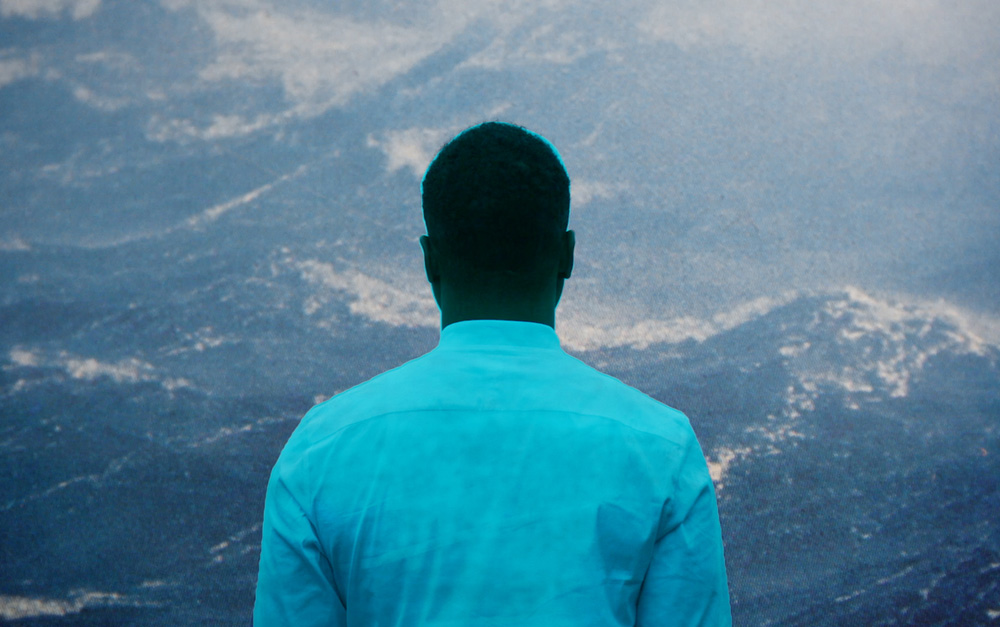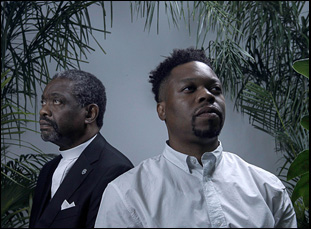“There’s a birth place and a home place,” Jon-Sesrie Goff’s father Dr. Rev. Norvel Goff tells his son at the start of “After Sherman,” to which the director wonders what’s the difference. “Your birth place is Hartford, Connecticut, your home place is Georgetown, South Carolina.”
The younger Goff has since moved to New York where he’s pursued a career as a filmmaker and after a brief time up north, Rev. Goff has returned to his family’s roots in South Carolina where he has only deepened their ties to the Black community along the coast as a minister at the AME Church, carrying on a proud tradition that transcends religion when it’s provided support for generations of descendants of those who were first brought to America as slaves. As Rev. Goff reminds, the water that runs around the perimeter of the land connects directly to the Caribbean where Spanish conquistadors had forced ancestors of theirs onto their boats and now no matter any travels they may do, they are inevitably connected to this place, which should be a point of pride rather than shame when simply to endure has taken incalculable strength and resolve and the community there now known as the Gullah Geechee has grown into one as mighty as they come.
It’s this indestructible backbone that allows the filmmaker to craft an sprawling and unforgettable debut that reveals so richly the sense of being tied to land that nonetheless feels elusive for the locals, tracking a present moment in which it seems in spite of all they’ve invested, it doesn’t belong to them as developers now see the beaches as territory ripe for pricey resorts and condos and the tragedy of the racially-motivated 2015 massacre at Charleston’s Emanuel AME threatened to unravel the fabric of the community. When Rev. Goff could’ve easily been at the church when it was attacked, eventually tending to those still alive and shaken by the experience, his son looks back at their family tree and beyond to understand the shaky foundation on which the community admirably made do, looking to the deal that Black reverends struck at the end of the Civil War with Union Army General William Tecumseh Sherman to emancipate anyone who was still enslaved, granting the nation a fresh start of sorts, but still leaving anyone who was already relocated against their will at a loss.
The fractured experience that emerged is inventively conveyed by Goff, who surveys those within his own family and outside of it who live in the Gullah to collectively scrap together impressions and memories that exist in the film as it does in their reality as the most powerful form of currency they have, seeing history constantly threatening to repeat itself if not for the trust they’ve built in each other along the way and the knowledge that they all have something to add, a point emphasized beautifully by the fact that none of the voices in the film are acknowledged individually by name. There’s plenty of poetry in “After Sherman,” including the fact that as the director makes the point of the residents of the Gullah making the region so unquestionably their own, he does the same with such a unique perspective, and after the film’s celebrated run on the festival circuit that began last year at True/False, it is floating into theaters this week, including stops at DCTV in New York (June 2-8), the Laemmle NoHo (June 5th) and the Alice Gill-Sheldon Theatre in Sedona, Arizona (June 6th) where the director is making appearances and he graciously made the time to talk to us about uncovering unknown corners of his family history, tying such a unique cinematic experience together using sound and carrying on with the production in the wake of the AME Church tragedy.
Being an indie filmmaker and working in my community, I knew I’d be able to have access to spaces to tell a story and I wanted to tell a Gullah Geechee story. Originally, I wrote a script called “Old Time Religion” based on a story that my aunt told me. When she was very young, she got very sick and she started having visions of ancestors and family members coming to her and a cousin that had recently died had invited her to play in this dream, so she told her father — my grandfather — and he went to visit a root doctor Dr. Buzzard, [who] prescribed a ritual for him to do, which he did. [And in the script] I contrasted that story with my grandmother, who is a very Christian, Southern person, and in my imagination, [it was a question of] which magic worked? Was it my grandmother praying or was it this ritual that my grandfather did? That line of inquiry that persisted [led me to] want to know more. [laughs]
In a case like this, does a family story give you permission to ask questions you wouldn’t otherwise as a relative?
Totally. That was the impetus behind the film. I used the camera as a way to interrogate my family about this plot of land we weren’t using because I didn’t feel like I was getting the answers I wanted in casual conversation, so when I did the set up and brought in the crew, they were like, “Oh, this is for real.” [laughs] and I think people spoke more freely and I appreciated that.
Was there anything that surprised you getting closer to the history?
I learned people’s real names [for the first time]. I’m like, “Who are you talking about?” And they’re like, “Oh that’s…” [laughs] Then there’s all these stories being coastal water people, and there’s always the joke about black people not knowing how to swim and I uncovered a lot of trauma related to water. My grandmother had a sibling who drowned in the water, playing at the beach when she was very young, and most of the men in the community worked on the docks — my grandfather was a longshoreman, and there were stories of men going out to fish out on a boat and not returning, so whether they were drowning or other events occurring, there were a lot of men and women who went out and would not return. I didn’t know those stories before making this and there is a remembrance of this trauma that I think keeps people away from the water.
It was striking to me how there seemed to be no separation between the past and present. Was that difficult to synthesize?
Yeah, for many traditions and cultures, time is this linear thing and for me, the history is present and the present is rooted in the past, so you have to acknowledge all of those things when you’re moving through certain spaces. That was the hardest thing to explain to people before we finished the film and one of the biggest concerns that people had when they read our treatment or when we discussed the project.

Yeah, the projections on the trees were something I knew I wanted to do. Those headlines were from newspaper articles that I researched dating back to the Denmark Vesey uprising from the 1850s, and 2015 was the last newspaper headline I used, “Blood at the Root,” which was the headline of the New Yorker article about the Charleston shooting. I extracted those headlines and made screen prints out of them and then turned them into projections. I visualized projected them onto this tree in Charleston for a long time and I was like, “We just have to do it.” And we were able to pull it off.
You’ve said after the AME shooting, you thought about not continuing on with the filming. What pushed you forward ultimately?
Ultimately, what pushed me forward was misconceptions of people coming in to tell the story of Charleston or the shooting. One person who was with a production came in and we were at a lunch together and this person, being from Virginia, turned to me and said, “Yeah, Charleston is the most racist place in America.” And I was like, “I would beg to differ there…” Racism is a national crisis, and I wouldn’t say it’s unique to Charleston or to South Carolina, so I wanted to show something that was also prideful because I still love South Carolina and the low country, so I had to show my vision of the space. That’s when I knew I had to keep on with the film.
This gave me an understanding of the church I’ve never had before…
Me too. [laughs]
What was it like to build that history?
The history of the AME Church has always fascinated me and when I think of the church, I’m not always thinking of it in the religious context, which is how I try to present it in the film. The AME Church actually grew out of the Free African Society, which was founded around the time of the founding of the United States [from a] group of Free Africans living in Philadelphia of various religious backgrounds, so it was never meant to be a religious structure. It was a society [developed] to help take care of widows and children after these free African men died and because there were difficulties in organizing in America, which was a very Christian colonial society, that’s when the formalized AME Church was made. But that thread of mutual aid runs through and at a time when there were these were communities that were 85%-90% African, they had to develop those things themselves. In the Praise House [for instance], it wasn’t just a place for worship, it was a place for restorative justice. It was a place of education. It was a place of economic sovereignty and interdependence, and all those things were operating in the idea or within the frame of the church building, but it was more than religion.
You’ve said when you got back to the editing room, there were a lot of different versions of this movie. How’d you end up with the one you put on screen?
We had to stop editing. [laughs] No, we wound up with this version when I was able to connect with our editor Blair McClendon and Blair was just a brilliant thought partner. After we worked together for maybe a year on the edit, there was nothing left to do. I was like, “This feels right.” That’s where we were able to end it. We tried it many other ways and configurations and once we realized that the protagonist was really my dad, that gave me the ability to step back and interject my voice and the artist hand being more present than my physical self. It was always a collage work for me, and once we set the goal that it would be a feature, we were just putting together the collage until we could get that far.
The music helps tie it together and from what I understand, your composer Tamar Kali has Gullah roots. Was that a connection?
That was. We actually collaborated on another project with another Gullah artist, but when we met, we realized that our families had already known each other. My cousin Bunny, who was featured in the film and was one of the first people I spoke to, she was a cultural worker in the area, and when she would go to visit St. Helena’s Island where Tamar’s family is from, she would actually stay with her family, so we had this connection that predated us even meeting, so it was kismet that we would work together on this.
And because I’m such a visual person, I don’t always follow what’s being said in a film and I also wanted to respect that sonically for people who may lean more into the soundscape. I wanted it to almost cast a spell at certain points with the language we used and that’s what Tamar took and ran with and just composed something really unexpected. She used a string quartet and she was having these classical musicians play their instruments in patterns that just weren’t classical. They were knocking on the instruments and plucking the strings in reverse order and all these cool techniques to really make it atmospheric.
At what point did you figure out the soundscape or how interviews would be used as voiceover?
That was rooted in other works I was doing. I have an ongoing short film that I call a serial film, modeled after the serial poetry of Anthony Mackie where he goes back and continues to work on this [one] piece. The way in which I constructed that film, I used a lot of audio recordings of family and friends and for a year, I would just record any conversation I would have, which made people not want to talk to me that much. [laughs] I was just gathering a lot of audio and I knew I wanted to bring in some of that technique of playing with just audio and letting that stand on its own complementary to the visual.
What’s it been like taking the film out into the world?
It’s been cool because it’s a weird film, intentionally [so] and making is one thing and then sharing and doing the festival circuit is another. I couldn’t have imagined this journey for the film from the onset. Like I thought we would do True/False and maybe in 20 years, I could screen it at a Flaherty Seminar, like those were literally my aspirations in making it, so to be able to share it with audiences at festivals around the country has been incredible. It’s just really been incredible to watch people experience this film. [And many of the people in it got to see many versions along the way — there is a youth conference every summer [in Charleston] and I actually presented it there twice while developing it and it was cool because people were just excited to see themselves or family or community members [on screen]. I don’t think people watched the film much because everyone’s like, “Oh did you see…? Can you turn it back?” That was super-exciting and that’s the gift that I ultimately wanted to give the community was a reflection back of all the love that they showered on me.
“After Sherman” will open in New York on June 2nd at the Firehouse Cinema and will screen on June 5th at the Laemmle NoHo 7.





